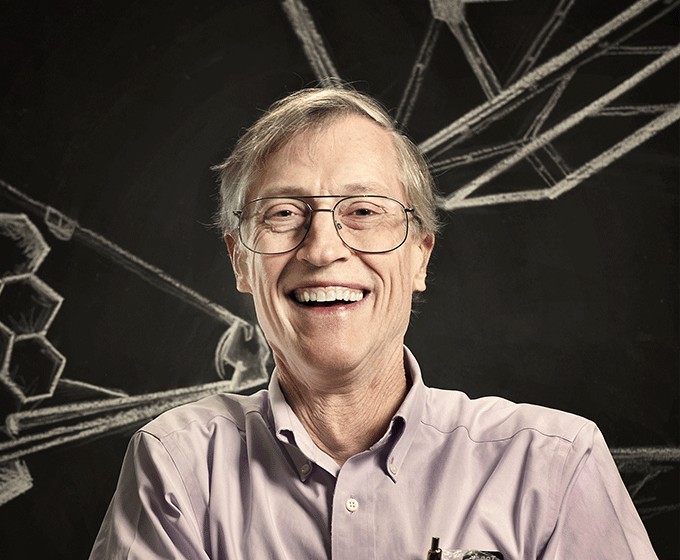
MARCH 18, 2024 — In anticipation of the total solar eclipse on Monday, April 8, UTSA will host Nobel laureate John C. Mather for a public talk at 7:30 p.m. this week on Thursday.
Mather is a senior astrophysicist at NASA and was the senior project scientist for the James Webb Space Telescope (JWST) at the Goddard Space Flight Center (GSFC), where he led the JWST science teams from 1995 to 2003. In 2006, he and colleague/fellow astrophysicist George Smoot received the Nobel Prize in Physics.
“The James Webb Space Telescope and its new window on the universe are some of humanity’s greatest achievements, and I’d like to share them with the students and the public,” Mather said.
Mather’s visit to UTSA is representative of the university's growing reputation as a hub for physical sciences and astronomy and reaffirms UTSA's space-related expertise, research programs and community engagement.
Mather’s talk, “Opening the Infrared Treasure Chest with JWST,” will focus on the James Webb Space Telescope, including its launch and development, and its use in explaining the origin stories of distant galaxies.
Space science leaders around the world use the JWST to produce images of galaxies, active galactic nuclei, star-forming regions and planets. Mather will explain why astronomers study infrared wavelengths, and he will share the latest scientific space discoveries.
The event, which is free and open to the public, will take place at the Main Building Auditorium (MB 0.104) on the UTSA Main Campus.
Mather hopes his audience will gain an understanding of where they came from, how the expanding universe produced planets like Earth, and what’s next for astronomy.
As a postdoctoral fellow at NASA’s Goddard Institute for Space Studies, Mather led the proposal efforts for the Cosmic Background Explorer (COBE) satellite. With the COBE team, he confirmed the expanding universe model to extraordinary accuracy and helped cement the big bang theory of the universe. The COBE team made the first map of the hot and cold spots in the background radiation, the spots which nucleated the formation of galaxies.
Mather and Smoot earned the Nobel Prize in 2006 for their work using the COBE satellite to provide evidence of the big bang theory.
Mather received his bachelor’s degree in physics from Swarthmore College in Pennsylvania and his doctorate in physics from the University of California, Berkeley.
The upcoming total solar eclipse, the chance to share this phenomenon with the public and the opportunity to reconnect with old friends was an opportunity that Mather could not pass up.
“I have friends and colleagues at UTSA, and I’ve been hoping to come back to visit,” Mather said. “And of course, there’s an eclipse, one of the most glorious and mysterious sights we will ever witness.”
“Dr. Mather has made substantial contributions to our understanding of the universe in which we live, and we are honored to host him at UTSA,” said Eric Schlegel, the Vaughan Family Professor in Physics at UTSA. “These events are a wonderful opportunity for students interested in pursuing careers in physics, astronomy or engineering to hear from someone who is recognized as a Nobel laureate for his groundbreaking scientific achievements.”
UTSA Today is produced by University Communications and Marketing, the official news source of The University of Texas at San Antonio. Send your feedback to news@utsa.edu. Keep up-to-date on UTSA news by visiting UTSA Today. Connect with UTSA online at Facebook, Twitter, Youtube and Instagram.
Día en la Sombrilla, formerly Fiesta UTSA, is a festival hosted each spring as a part of Fiesta® San Antonio events. Sponsored by Roadrunner Productions, the event features music, food, confetti, games, event t-shirts, and more.
Sombrilla Plaza, Main CampusCovidence is a systematic & scoping review tool used to streamline the process of screening and reviewing articles. Using this software, research teams can easily import studies, perform automatic deduplication, and extract data using templates. This workshop will show attendees how to start a review in Covidence, add collaborators, and get started on screening.
Virtual (Zoom)In this workshop, attendees will be introduced to Pandas, a Python tool for working with data easily. It makes it simple to organize and analyze information when data is organized and categorized, like spreadsheets or tables.
Group Spot B, John Peace LibraryEach fall and spring semester, students convene at the Main Campus at UTSA with booths, ideas and prototypes. A crowd of judges, local organizations, students, faculty and sponsors walk around and talk to the students about their projects and ask questions. Students get the real-life experience of "pitching" their project with hopes of getting funding or support to move to the next level.
UTSA Convocation Center, Main CampusJoin the doctoral candidates for the Doctoral Conferreal Ceremony and celebrate their accomplishments.
Arts Building Recital Hall, Main CampusCelebrate the graduates from the Carlos Alvarez College of Business, College of Education and Human Development, Margie and Bill Klesse College of Engineering and Integrated Design and University College.
AlamodomeCelebrate the graduates from the College for Health, Community and Policy, College of Liberal and Fine Arts and College of Sciences.
AlamodomeThe University of Texas at San Antonio is dedicated to the advancement of knowledge through research and discovery, teaching and learning, community engagement and public service. As an institution of access and excellence, UTSA embraces multicultural traditions and serves as a center for intellectual and creative resources as well as a catalyst for socioeconomic development and the commercialization of intellectual property - for Texas, the nation and the world.
To be a premier public research university, providing access to educational excellence and preparing citizen leaders for the global environment.
We encourage an environment of dialogue and discovery, where integrity, excellence, respect, collaboration and innovation are fostered.